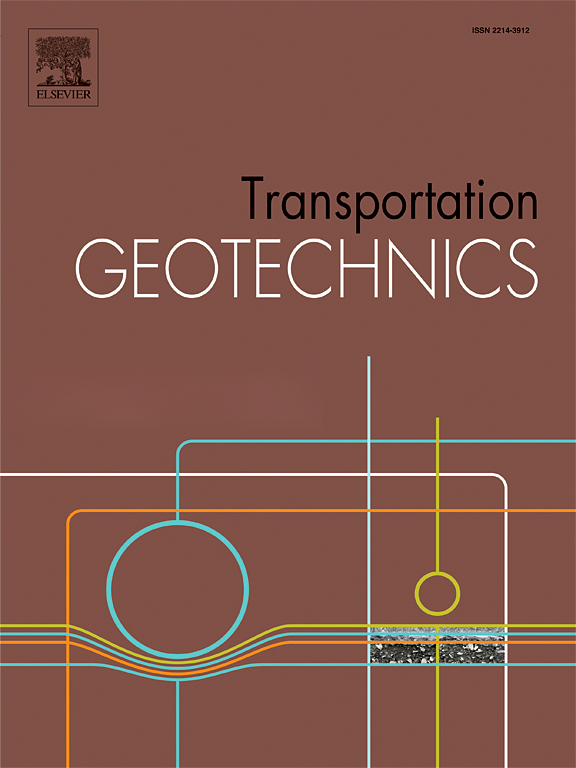Assessment of landslide susceptibility along the Lanzhou-xinjiang high-speed railway: A case study of Menyuan-Shandanmachang
IF 4.9
2区 工程技术
Q1 ENGINEERING, CIVIL
引用次数: 0
Abstract
The Menyuan-Shandanmachang section of the Lanzhou-Xinjiang High-Speed Railway is located in the cold and high-elevation area at the northeastern edge of the Qinghai-Tibet Plateau, where geological activities are frequent and earthquakes occur often. Meanwhile, this section has become a more sensitive region for the transition from alpine permafrost to deep-seasonal frozen soil due to the warming of the climate. A large number of landslides introduced by earthquakes and freeze–thaw processes cause a serious threat to railway safety. This investigation first explored the spatial distribution characteristics of landslides in the study area by overlapping raster data of 255 landslide samples triggered by the 2016 Menyuan Ms6.4 Earthquake and 12 influencing factors. Subsequently, 255 non-landslide samples were randomly generated in the non-landslide areas to form a database by combining them with the above-mentioned landslide samples. The logistic regression (LR), support vector machine (SVM), and random forest (RF) machine learning models were trained (70 %) and validated (30 %) in a 7:3 split method. The model accuracy was evaluated by using the Receiver Operating Characteristic curve (ROC) and Area Under Curve (AUC). Then, the trained models were used to predict the landslide susceptibility for the 2016 Menyuan Ms6.4 Earthquake and the 2022 Menyuan Ms6.9 Earthquake, respectively. The prediction results were contrasted by landslide samples and the inversion results of InSAR surface deformation to evaluate the performance of the ML models. The results show that the main controlling factors of landslide disasters are elevation, seismic intensity, distance to fault, plane curvature, and rainfall. The prediction accuracy of the three models is RF (0.773) > SVM (0.747) > LR (0.682). The landslide warning degree of RF is higher than that of the other two models, but it performs poorly in the detailed depiction of low-seismicity areas. Although the prediction accuracy of the SVM model is slightly lower than that of RF, it has higher stability and generalization ability. Both models can be used as reference models for predicting the susceptibility of earthquake-induced landslides in the study area. This investigation provided the threshold values of influencing factors with relatively high landslide frequencies in this study area and explored the corresponding mechanism. Multiple evaluation methods combining quantitative analysis, landslide sample analysis, and InSAR surface deformation analysis were adopted to improve the reliability of the evaluation results. The complexity of the geographical environment, the particularity of the geographical location, and the diversity of verification methods for research results contribute to the uniqueness of this study. The research results can offer analysis methods and technical means for the temporal and spatial distribution and evolution characteristics of landslide disasters along the Lanzhou-Xinjiang High-Speed Railway, and also serve as a reference model for the prediction and warning of landslide susceptibility in similar areas.
求助全文
约1分钟内获得全文
求助全文
来源期刊

Transportation Geotechnics
Social Sciences-Transportation
CiteScore
8.10
自引率
11.30%
发文量
194
审稿时长
51 days
期刊介绍:
Transportation Geotechnics is a journal dedicated to publishing high-quality, theoretical, and applied papers that cover all facets of geotechnics for transportation infrastructure such as roads, highways, railways, underground railways, airfields, and waterways. The journal places a special emphasis on case studies that present original work relevant to the sustainable construction of transportation infrastructure. The scope of topics it addresses includes the geotechnical properties of geomaterials for sustainable and rational design and construction, the behavior of compacted and stabilized geomaterials, the use of geosynthetics and reinforcement in constructed layers and interlayers, ground improvement and slope stability for transportation infrastructures, compaction technology and management, maintenance technology, the impact of climate, embankments for highways and high-speed trains, transition zones, dredging, underwater geotechnics for infrastructure purposes, and the modeling of multi-layered structures and supporting ground under dynamic and repeated loads.
 求助内容:
求助内容: 应助结果提醒方式:
应助结果提醒方式:


